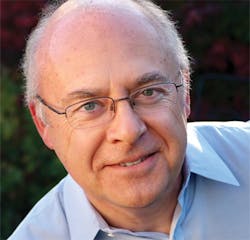
By any measure, last month's SEMICON West event in San Francisco, CA provided a welcome boost to photonics market watchers. Attendance was up 20% compared to last year, and one semiconductor company CEO–while referring to the current business outlook in this sector–stated, "I'm as excited as I've been since the mid-90s." Some recent forecasts suggest a huge surge in sales for many sectors of semiconductor equipment suppliers. In fact, it seemed like everyone was in a good mood, though there are lingering concerns about the longer-term outlook. Nonetheless, semiconductor and microelectronics processing is a bellwether segment of the photonics industry–it drives annual sales of more than 5% of all lasers sold globally, as well as multiple other optical components and systems–so we can expect to see this upturn reflected in upcoming financial reports from key suppliers of lasers and photonics equipment. You can find a more detailed report about the conference online at laserfocusworld.com (see http://bit.ly/cM3FjC).
Optically based measurement systems are critical to the successful production of semiconductors and they account for much of the aforementioned photonics revenues in this sector. Such systems are also important in many other areas of photonics. Ellipsometry can provide detailed characterization of optical thin films. Modern systems combine spectroscopic analysis with sophisticated processing software to provide turnkey metrology of substrates and thin-film samples (see page 31). And in the manufacture of aspheric lenses, interferometry offers a solution to the growing need for high-resolution full-aperture metrology. The concept of the variable optical null maintains the benefits of subaperture stitching interferometry, while increasing its aspheric departure capability (see page 49).
At the National Renewable Energy Laboratory (Golden, CO), historical measurements track the progress made in advancing solar cell efficiency over the past 33 years. Performance has improved consistently but slowly–efficiency has hardly doubled since 1977. Now, new designs and structures are being explored in the hope they can provide a big boost to photovoltaic conversion efficiency (see page 54).
About the Author
Stephen G. Anderson
Director, Industry Development - SPIE
Stephen Anderson is a photonics industry expert with an international background and has been actively involved with lasers and photonics for more than 30 years. As Director, Industry Development at SPIE – The international society for optics and photonics – he is responsible for tracking the photonics industry markets and technology to help define long-term strategy, while also facilitating development of SPIE’s industry activities. Before joining SPIE, Anderson was Associate Publisher and Editor in Chief of Laser Focus World and chaired the Lasers & Photonics Marketplace Seminar. Anderson also co-founded the BioOptics World brand. Anderson holds a chemistry degree from the University of York and an Executive MBA from Golden Gate University.